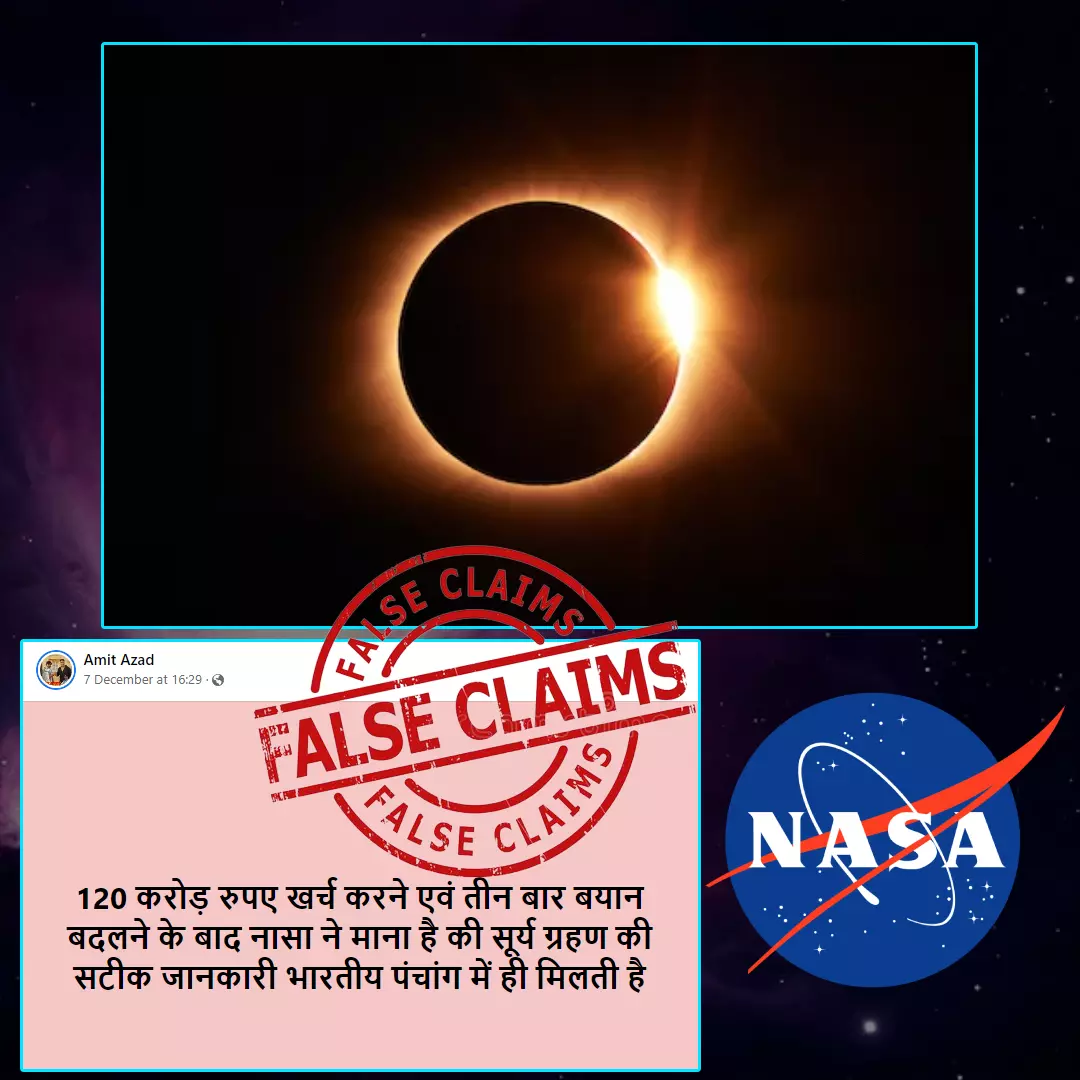
Image Credit: Pixabay, Unsplash, Facebook/Amit Azad
No, Nasa Did Not Admit That It Consults The Hindu Panchang For Predicting Solar Eclipses; Viral Claim Is Misleading
Writer: Jakir Hassan
A journalist at heart loves the in-depth work of reporting, writing, editing, research, and data analysis. A digital and social media enthusiast.
India, 10 Dec 2022 9:54 AM GMT
Editor : Bharat Nayak |
As the founding editor, Bharat had been heading the newsroom during the formation years of the organization and worked towards editorial policies, conceptualizing and designing campaign strategies and collaborations. He believes that through the use of digital media, one could engage the millennial's in rational conversations about pertinent social issues, provoking them to think and bring a behavioral change accordingly.
Creatives : Jakir Hassan
A journalist at heart loves the in-depth work of reporting, writing, editing, research, and data analysis. A digital and social media enthusiast.
A claim is going viral across social media alleging that the US space agency NASA has accepted that credible information regarding solar eclipses can only be obtained from the Hindu calendar Panchang. The Logical Indian Fact-Check team found that the claim originated from a satirical news website.
A claim is going viral across social media alleging that the US space agency NASA has accepted that credible information regarding solar eclipses can only be obtained from the Hindu calendar Panchang. The US space agency has been the center of a series of misleading claims about climate change and astronomy.
Claim:
The claim reads, "After spending Rs 120 crores and changing their opinions three times, NASA accepted that accurate information about the solar eclipse is contained in Indian Panchang".
The claim is viral on social media.
Fact Check:
The Logical Indian fact-check team verified the viral claim and found it misleading. The claim spread via a satirical news website.
We conducted a keyword search with the same keywords and came across posts on Twitter from April 2018, which indicated that the claim has been viral in the past.
We then conducted a keyword search regarding how NASA predicts solar eclipses. We came across a report on a NASA website dedicated to the Solar System, briefly noting how scientists predict solar eclipses.
The NASA report noted that astronomers must first work out the geometry and mechanics of how Earth and the Moon orbit around the Sun. These astronomers determine the impact of influences of the gravitational fields of these three bodies in their calculations.
Using Newton's laws of motion, scientists use mathematical equations to understand the motions of these celestial bodies in three-dimensional space.
Scientists then enter the current positions and speeds of Earth and the Moon into complex equations and then set a computer program to "integrate" these equations forward or backward in time to calculate the relative positions of the Moon and Sun as seen from the vantage point of Earth.
"Eclipses are specific configurations of these bodies that can be identified by the computer. Current eclipse forecasts are accurate to less than a minute in time over a span of hundreds of years," the report noted.
We also came across a report published on Space.com, which provided further details on how scientists predict solar eclipses. The report noted that at least twice each year, with certain exceptions, an alignment of a new moon in a way to eclipse the Sun.
Terming this alignment point as a node, the report states that depending on the new moon's approach to a node would ascertain whether a particular eclipse is central or partial. The moon's distance from the Earth and the Earth's distance from the Sun will affirm the type of eclipse: central eclipse total, annular or hybrid.
"After a specific interval of time, an eclipse will repeat itself or return. This interval is known as the Saros cycle and was known as far back as the days of the early Chaldean astronomers some 28 centuries ago. The word Saros means "repetition" and is equal to 18 years, 11⅓ days (or a day less or more depending on the number of leap years that have intervened)."
We also found a forum conversation on NASA's official website on eclipses and how it connects to the Hindu religion. A solar astronomer from NASA's Marshall Space Flight Center replied to a query by a person who alleged that eclipses occur when a "snake swallows up the sun."
The astronomer replies that solar eclipses in the Hindu religion are associated with concepts of Rahu and Ketu which are connected with nodes of the moon's orbit. The astronomer refers to the ecliptic when the nodes occur, leading to the possibility of eclipses.
"Tradition says that Rahu is the head of a demon, and Ketu is the tail. I suspect that the ancient Hindu actually knew about the nodes," the NASA astronomer notes.
As per an India Today report, in Hindu mythology, from time to time, Rahu is an entity that catches up with the Sun and the Moon and swallows them, which causes the eclipse. The incident doesn't last long because Rahu has no hands to grab onto these two celestial gods.
In our Fact Check, we came across a write-up published in the 'The Fauxy' website, which publishes fictitious information passing it off as news for satirical and entertainment purposes. The write-up titled, 'NASA Scientist Confesses Using Hindu Calendar 'Panchaang' To Accurately Forecast Eclipses And Other Astronomical Events' was published on 26 June 2021.
Conclusion:
We found that the claim that NASA finally acknowledged that it uses the Hindu calendar Panchang for predicting solar eclipses is misleading. NASA scientists predict the solar eclipse through a range of complex mathematical equations depending on factors such as nodes, the moon's distance from the Earth, and the Earth's distance from the Sun. Rahu and Ketu from the Hindu religion are certain concepts that ancient Hindus possibly used to predict solar eclipses, as per an astronomer at NASA. However, it is clear that the viral claim originated from a satirical news website. Thus, we can ascertain that the viral claim is misleading.
If you have any news that you believe needs to be fact-checked, please email us at factcheck@thelogicalindian.com or WhatsApp at 6364000343.
 All section
All section














